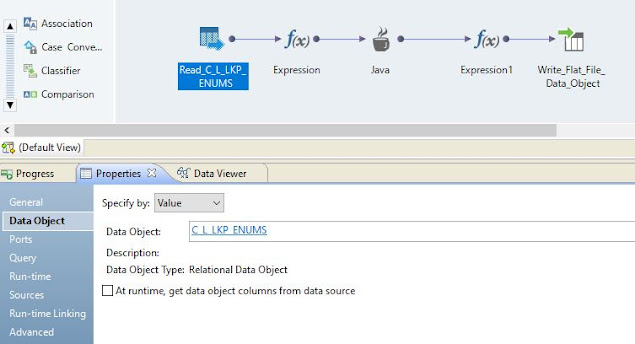In this article, we will understand various sample requests using Informatica Business Entity Services. The sample requests are prepared using PKEY_SRC_OBJECT and ROWID_OBJECT values. The server name, port, and other parameters need to be updated specifically to your project.
1: Get request using PKEY_SRC_OBJECT
https://localhost:8080/cmx/cs/orcl-CMX_ORS/Customer/SFA:PKEY_000001?systemName=SFA&depth=5&suppressLinks=true
2: Get request using 'query' parameter
https://localhost:8080/cmx/cs/orcl-CMX_ORS/Customer?systemName=SFA&depth=2&suppressLinks=true&action=query&filter=CustomerAdditionalInformation.xslpTaskId={{SFATaskNumber}}
3: Create a new customer
Endpoint: https://localhost:8080/cmx/cs/orcl-CMX_ORS/Customer?systemName=SFA&depth=2&suppressLinks=true
Request Body:
{
"key":{ "sourceKey": "PKEY_00000021" },
"fullNm": "Sample Customer 123",
"fstNm": "KC First Name",
"lstNm": "KC Last Name",
"partyType":"",
"CustomerAltIdSMPLCustId":
{ "item": [
{
"key":{ "sourceKey": "PKEY_0000002~SMPLID" },
"SMPLCustId":"123"
}
]
},
"CustomerAltIdSMPLCustUniqId":
{ "item": [
{
"key":{ "sourceKey": "PKEY_0000002~SMPLUniqId" },
"SMPLCustUniqId":"123"
}
]
},
"CustomerAltIdContractId":
{ "item": [
{
"key":{ "sourceKey": "PKEY_0000002~CNTRID" },
"ContractId":"123"
}
]
},
"PartyAddress":
{ "item": [
{
"key":{ "sourceKey": "PKEY_0000002-SHIP" },
"xaddrtyp":"Shipping",
"xaddrln1": "123 ST",
"xaddrln2": "",
"xcity": "New York",
"xcntrycd": "US",
"xstprvnc": "NY",
"xpstlcd": "10101"
}
]
},
"CustomerAlternateNames":
{ "item": [
{
"key":{ "sourceKey": "PKEY_0000002~FORMAL" },
"altNm":"FORMAL_1234",
"xprtyAltNameType":"Does Business As (FORMAL)"
}
]
},
"CustomerPhone":
{ "item": [
{
"key":{ "sourceKey": "PKEY_0000002~PHONE" },
"phnNum":"123456890",
"phnTypeCd":"Telephone"
}
]
},
"CustomerPartyParentRel":
{ "item": [
{
"key":{ "sourceKey": "PKEY_000001~PKEY_0000002" },
"CustomerPartyParent" : {
"key":{ "sourceKey": "PKEY_000001" }
}
}
]
}
}
4. Update customer using rowid_object
Endpoint: https://localhost:8080/cmx/cs/orcl-CMX_ORS/Customer/rowId?systemName=SFA&suppressLinks=true&depth=2
Request Body:
{
"rowidObject":{{SFDCMDMID}},
"fullNm": "Integration Update Test 890",
"fstNm": "Samle first Name 890",
"lstNm": "Samle last Name 890",
"AccntStsCode": {
"accntstscd": "CUST"
},
"$original": {
"fullNm": "fullNm",
"fstNm": "fstNm",
"lstNm": "lstNm",
"AccntStsCode": {
"accntstscd": "CUST"
}
},
"CustomerAltIdTaxId": {
"$original":{"item":[null]},
"item": [
{
"key": {
"sourceKey": "PKEY_0000003~TAXID"
},
"taxId": "tax01"
}
]
},
"CustomerAltIdABC_CORPOfficeNumber": {
"$original":{"item":[null]},
"item": [
{
"key": {
"sourceKey": "PKEY_0000003~ABC_CORPRTLSNUM"
},
"ABC_CORPOfficeNum": "ABC_CORPOffice01",
"xaltIdType": "ABC_CORP Office Number"
}
]
},
"CustomerAltIdGovLicNum": {
"$original":{"item":[null]},
"item": [
{
"key": {
"sourceKey": "PKEY_0000003~GOVLICID"
},
"GovLicNum": "tc001",
"xaltIdType": "Gov License Number"
}
]
},
"CustomerPartyParentRel": {
"$original":{"item":[null]},
"item": [
{
"key": {
"sourceKey": "PKEY_0000003~HeadQuarter"
},
"xprtyPrnt":8
}
]
}
}
5: Update customer using PKEY_SRC_OBJECT
Endpoint URL: https://localhost:8080/cmx/cs/orcl-CMX_ORS/Customer?systemName=SFA&suppressLinks=true&depth=2
Request Body:
{
"key": {
"sourceKey": "PKEY_0000003"
},
"fullNm": "Integration Update Test 6",
"fstNm": "Samle first Name 6",
"lstNm": "Samle last Name 6",
"xhastbcclcnsflg": "1",
"xnsleffctvdt": "2015-08-19T00:05:31.630+05:30",
"xnslpblshddt": "2015-08-19T00:05:31.630+05:30",
"AccntStsCode": {
"accntstscd": "CUST"
},
"$original": {
"fullNm": "fullNm",
"fstNm": "fstNm",
"lstNm": "lstNm",
"AccntStsCode": {
"accntstscd": "CUST"
}
},
"CustomerAltIdTaxId": {
"item": [
{
"key": {
"sourceKey": "PKEY_0000003~TAXID"
},
"taxId": "tax01"
}
]
},
"CustomerAltIdABC_CORPOfficeNumber": {
"item": [
{
"key": {
"sourceKey": "PKEY_0000003~ABC_CORPRTLSNUM"
},
"ABC_CORPRtlSoreNum": "ABC_CORPOffice01"
}
]
},
"CustomerAltIdGovLicNum": {
"item": [
{
"key": {
"sourceKey": "PKEY_0000003~GOVLICID"
},
"GovLicNum": "tc001"
}
]
},
"CustomerPartyParentRel": {
"item": [
{
"key": {
"sourceKey": "PKEY_0000003~HeadQuarter"
},
"CustomerPartyParent": {
"key": {
"sourceKey": "PKEY_0000005"
}
}
}
]
}
}




































